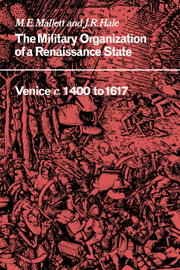Book contents
- Frontmatter
- Contents
- List of illustrations
- Acknowledgements
- References and abbreviations
- Map 1 The Terraferma in the fifteenth and sixteenth centuries
- Map 2 The empire da Mar
- PART I c. 1400 to 1508
- Introduction: the European context 1400–1525
- 1 The beginnings of Venetian expansion
- 2 The composition and role of the army in the fifteenth century
- 3 Military development and fighting potential
- 4 The organization and administration of the Venetian army
- 5 Control and policy making
- 6 Soldiers and the state
- 7 Venice and war
- PART II 1509–1617
- Conclusion: the European context 1525–1617
- Appendix Infantry wages in the sixteenth century
- Select bibliography
- Index
4 - The organization and administration of the Venetian army
Published online by Cambridge University Press: 22 October 2009
- Frontmatter
- Contents
- List of illustrations
- Acknowledgements
- References and abbreviations
- Map 1 The Terraferma in the fifteenth and sixteenth centuries
- Map 2 The empire da Mar
- PART I c. 1400 to 1508
- Introduction: the European context 1400–1525
- 1 The beginnings of Venetian expansion
- 2 The composition and role of the army in the fifteenth century
- 3 Military development and fighting potential
- 4 The organization and administration of the Venetian army
- 5 Control and policy making
- 6 Soldiers and the state
- 7 Venice and war
- PART II 1509–1617
- Conclusion: the European context 1525–1617
- Appendix Infantry wages in the sixteenth century
- Select bibliography
- Index
Summary
Throughout the fifteenth century the organization of the Venetian army continued to be based largely on the condotte between individual captains and the state. However, presented in these stark terms this gives an unduly static and conservative picture of that organization. During the century the nature of the contractual relationship changed considerably; contracts grew longer, embracing both war and peace service, and the large majority of the condottieri became accustomed to permanent service with the renewal of their contracts a formality. This increasing degree of permanence meant a growing need for a permanent administration which supervised the contracts, carried out inspections and provided centrally for the needs of the army. Inevitably the self-dependence of the companies was eroded, and many of the support services which had, in the fourteenth century, been handled by companies themselves as they moved from one employ to another became the responsibility of the employing state. At the same time considerable sections of the army were no longer organized on the basis of contractual employment, and these involved a centralized administration even more closely. Hence the starting point for this chapter must be a discussion of the emerging military administration.
During the wars of the early years of the century military administration was in the hands of Venetian nobles, elected for short terms, and a group of military advisers, mostly men from the Terraferma nobility who had previous military experience. These men, among them such figures as Ludovico Buzzacarini and Paolo di Leone, both Paduans and former advisers of the Carrara, were employed in various capacities ranging from subordinate military commanders to recruiters, inspectors and informal military advisers.
- Type
- Chapter
- Information
- The Military Organisation of a Renaissance StateVenice c.1400 to 1617, pp. 101 - 152Publisher: Cambridge University PressPrint publication year: 1984
- 1
- Cited by



